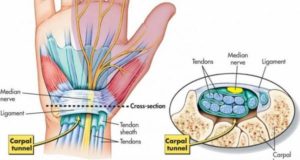
Carpal Tunnel Syndrome
What is it?
Carpal Tunnel Syndrome is compression of the Median Nerve as it travels on the palm-side of the hand, through the carpal tunnel (which is a ‘tunnel’ created by the carpal bones of the wrist and the transverse carpal ligament). The carpal tunnel houses 9 flexor tendons along with the Median Nerve. There is not much spare space within the carpal tunnel, and so any inflammation or swelling of the structures within it can place pressure on the Median Nerve and cause problems.
What are the signs?
Carpal Tunnel Syndrome happens because the Median Nerve gets compressed (“squashed”). Therefore, the symptoms occur in the areas that are supplied by the Median Nerve, particularly past the area of compression (I.e. In the hand).
The main signs and symptoms of Carpal Tunnel Syndrome include:
- Tingling, usually including the thumb, index, middle and half the ring finger (especially palm-side)
- Pain into the hand and occasionally up the forearm/arm
- Numbness, usually in the hand
- Weakness, particularly in gripping and with manual dexterity
- Wasting of the thenar muscles (the muscly part under your thumb)
These symptoms, especially the tingling/numbness often happen at night, or at periods of rest.
What causes it?
The main causes include:
- Pregnancy, due to increased fluid in general which may decrease the room inside the tunnel
- Wrist fracture – which may reduce the size of the tunnel
- Repetitive wrist work (which can include work with machinery/vibrations)
- Rheumatoid arthritis (more-so than Osteoarthritis) due to the swelling associated
- Repetitive computer work, or work that requires constant grip
- Genetic/Development reasons – some people have narrower carpal tunnels
Interestingly, Carpal Tunnel Syndrome most commonly affects women between the ages of 40 to 60 years. Of course, this is not exclusive!
What are the treatment options?
- Physiotherapy – there are many different treatments that a Physiotherapist can offer. These can include myofascial release or dry needling of tight muscles around the forearm, stretches and mobilisations of the median nerve along its length, mobilisation of the carpal bones, and mobilisation and release through the neck (at the start of the Median Nerve). Different treatments may be performed depending on your presentation. In addition, your physiotherapist can advise you on the correct stretches, exercises and splinting, and provide ideas on how to limit the aggravating activities. They may also suggest ice and anti-inflammatories according to your presentation. (Some stretches are shown below).
- Splinting, especially at night can prevent the wrist from moving into positions that cramp the space in the carpal tunnel. They can also be used during activities that are normally aggravating.
- Surgery to release the transverse carpal ligament and reduce the pressure on the Median Nerve is also an option. It would be recommended to exhaust conservative treatments prior to any surgery. However, if things are not improving with the conservative measures, then surgery may be considered. Your GP will need to refer you for a specialist review.
Following are several important stretches and exercises especially for Carpal Tunnel Syndrome:
Forearm Flexor Stretch
Stand, with your arm straight out and hand flat (fingers facing downwards) on the wall
Try to move your hand up as high as possible on the wall, until you feel a good stretch in the fingers, front of the wrist, or the forearm
Hold for 20 seconds, repeat often (every hour if possible!)
–
Tunnel Stretch
Place hands together, fingers pointing towards you
Aim to stretch the thumbs and little fingers as far away from each other (try to open up the tunnel)
Hold 20 seconds (or as comfortable), repeat often (every hour if possible!)
–
Median Nerve Stretch
(This will be the most awkward and confusing of the stretches!)
Start with your arm up (Pic 1), palm facing up
Slowly stretch the arm out straight, keeping the hand pulled back (Pic 2)
You can try to tilt your head to increase the stretch as you stretch out your arm
The stretch should be in the front of the elbow/forearm, or top of the wrist/fingers
Aim to hold 5 seconds, repeat 10 times (or as comfortable)
In Finishing
If you feel that the above information describes your pain and symptoms perfectly, please discuss this with your Physiotherapist or GP as soon as possible. You will likely require some form of treatment promptly, in order to limit future issues. You can certainly start the stretches above immediately!
To book an appointment at Therapia Physiotherapy and Pilates, to know more about Carpal Tunnel Syndrome, or to discuss any symptoms, please call us on (08) 8221 5011. Alternatively, you can email us at info@therapia.com.au
Book Appointment




